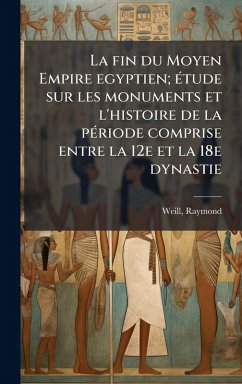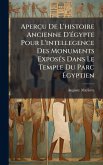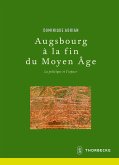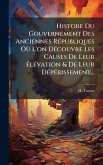La fin du Moyen Empire égyptien; étude sur les monuments et l'histoire de la période comprise entre la 12e et la 18e dynastie, written by Raymond Weill, explores the transitional period in ancient Egyptian history between the Middle Kingdom and the early New Kingdom. This detailed study examines the monuments and historical records from the 12th to the 18th dynasties, providing insights into the political, social, and cultural changes that marked this era. Weill's work offers valuable perspectives on the decline of the Middle Kingdom and the rise of the New Kingdom, making it an essential resource for Egyptologists and anyone interested in ancient Egyptian history. This work has been selected by scholars as being culturally important, and is part of the knowledge base of civilization as we know it. This work was reproduced from the original artifact, and remains as true to the original work as possible. Therefore, you will see the original copyright references, library stamps (as most of these works have been housed in our most important libraries around the world), and other notations in the work. This work is in the public domain in the United States of America, and possibly other nations. Within the United States, you may freely copy and distribute this work, as no entity (individual or corporate) has a copyright on the body of the work. As a reproduction of a historical artifact, this work may contain missing or blurred pages, poor pictures, errant marks, etc. Scholars believe, and we concur, that this work is important enough to be preserved, reproduced, and made generally available to the public. We appreciate your support of the preservation process, and thank you for being an important part of keeping this knowledge alive and relevant.
Bitte wählen Sie Ihr Anliegen aus.
Rechnungen
Retourenschein anfordern
Bestellstatus
Storno



![Catalogue des monuments et inscriptions de l'Égypte antique / publiÃ(c) sous les auspices de S.A. Abbas II Helmi par la direction gÃ(c)nÃ(c)rale du Service des antiquitÃ(c)s [de l'Égypte]; par J. de Morgan, U. Bouriant, G. Legrain, G. JÃ(c)quie Catalogue des monuments et inscriptions de l'Égypte antique / publiÃ(c) sous les auspices de S.A. Abbas II Helmi par la direction gÃ(c)nÃ(c)rale du Service des antiquitÃ(c)s [de l'Égypte]; par J. de Morgan, U. Bouriant, G. Legrain, G. JÃ(c)quie](https://bilder.buecher.de/produkte/75/75085/75085838m.jpg)

![Catalogue des monuments et inscriptions de l'Égypte antique / publiÃ(c) sous les auspices de S.A. Abbas II Helmi par la direction gÃ(c)nÃ(c)rale du Service des antiquitÃ(c)s [de l'Égypte]; par J. de Morgan, U. Bouriant, G. Legrain, G. JÃ(c)quie Catalogue des monuments et inscriptions de l'Égypte antique / publiÃ(c) sous les auspices de S.A. Abbas II Helmi par la direction gÃ(c)nÃ(c)rale du Service des antiquitÃ(c)s [de l'Égypte]; par J. de Morgan, U. Bouriant, G. Legrain, G. JÃ(c)quie](https://bilder.buecher.de/produkte/74/74918/74918977m.jpg)


